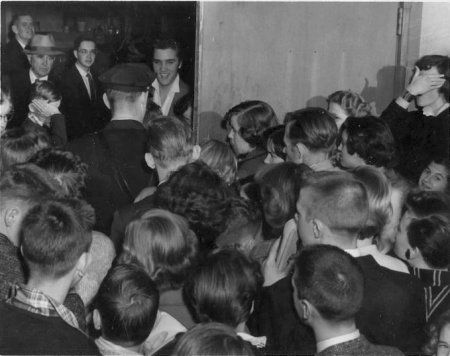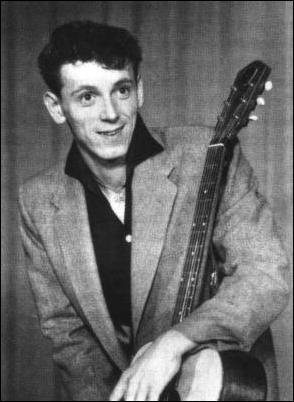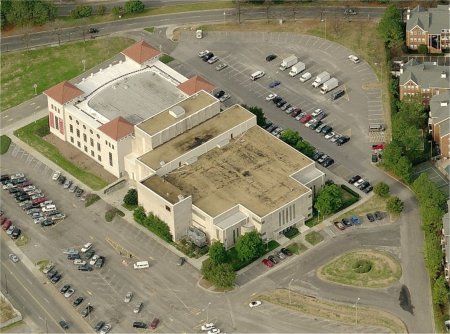 |
Municipal Auditorium - Norfolk, VA The Municipal Auditorium at East 9th and Granby Streets in Norfolk, VA was designed by Norfolk architect Clarence Neff and built during World War II as a result of the overwhelming military buildup that had doubled the city's population between 1938 and 1941. Combined with the military's intention of entertaining service personal and the city's long range interests, the Auditorium was built with combined funds of $278,000 from the Federal War Fund and $245,000 from the city.1
Neff's design for the Auditorium, in a style called "streamlined
moderne," contained a 3000 seat indoor arena/gymnasium/auditorium
and a separate 1800 seat theater, called the Center Theater, adjacent to
it on the other end.2 Finished in
May of 1943, the Auditorium hosted USO dances and shows, boxing matches,
wrestling matches and concerts. The first USO dance was held on July
31,1943.1
The theater was used for concerts, plays and high school and college graduations.3 On April 2, 1950, the theater helped launch the television age in Norfolk when WTAR (known later as WTKR) went on the air live from the Center Theater. The announcers read copy ripped off the national wires and then plunked down still photographs on an easel to illustrate the stories.1 William Douchette, while a country music disc jockey at Norfolk's WLOW took the name “Sheriff Tex Davis” because “Douchette” didn’t sound very country. In 1954, Davis opened Norfolk station WCMS, where he did disc jockey work and hosted talent contests for "Country Showtime" at a local theater on Friday nights. Vincent Eugene Craddock (Gene Vincent), a Norfolk native and recently discharged from the Navy after an injury in a motorcycle accident, would sometimes perform at those talent shows. Davis also booked Grand Ole Opry and other acts into the Municipal Auditorium's arena.4
On May 15, 1955, while touring with
Hank Snow's All Star Jamboree, Elvis, Scotty and Bill performed at the Municipal Auditorium
in Norfolk for the first time. By the time of their next appearances there that year, two on September 11th and one on the 12th, they were getting top billing (though they misspelled Elvis' last name in the advertisement ). They were joined by Hank's Jamboree for several dates and then they split off. Billboard magazine wrote, The "Hank Snow All-Star jamboree," headlined by Hank Snow and the Rainbow Ranch Boys, Elvis Presley, the Louvin Brothers and Cowboy Copas, played to packed houses at the Auditorium, Norfolk, Sunday and Monday of last week (11-12). The same unit is set for Asheville, N. C., and Roanoke, Va., with a smaller unit comprised of Presley, the Louvins and Copas, set to follow with New Bern, Wilson, Raleigh and Thomasville, all in North Carolina; Richmond and Danville, Va., and winding up in Kingsport, Tenn. The tour, packaged by Hank Snow Attractions, is being directed by Tom Diskin. Two big shows for Ralston Purina mill openings in Harrisburg, Pa., and Springdale, Ark., are being handled by Col. Tom Parker.5 |
||
|
On February 12, 1956, Elvis, Scotty, Bill and DJ made their last appearance at the Municipal Auditorium. They had only made their third television appearance the previous night on the Dorsey Brothers Stageshow and "Heartbreak Hotel" had been released just over two weeks earlier on January 27th with "I Was The One" its b-side. They appeared in Norfolk with Justin Tubb, again with The Louvin Brothers, and with the Carter sisters and Benny Martin.
Raymond H. Pulley was a student at the Oscar F. Smith High School in South Norfolk where he also worked as an engineer and disc jockey at the student-run radio station WFOS-FM, the first educational FM station in Virginia. Tex Davis of WCMS was his mentor. Ray hosted a daily two-hour program, "The Cuzin' Ray Hoedown," which featured rock and roll, country, and hillbilly music.6 Ray was in attendance for the shows on the 12th and interviewed the Carter sisters and Elvis for his program.
During the performances, Anita Carter played Bill's bass while Mother Maybelle played her Gibson L5 and Helen played accordion. June sang and told jokes
Brian Petersen, in the Atomic Powered Singer wrote, the next day one of the local papers reported that the Municipal Auditorium had its biggest day Sunday when a total of 9,900 fans of country-style music jammed into the arena for the three shows. This was the largest crowd for a single day since the Auditorium was opened.7
It was further reported that the crowd was so large that lines in front of the box office stretched all the way to Granby Street and that Elvis' records were selling at a rate of 100,000 a week.7
Gene Vincent saw one of Elvis' shows at the Auditorium and was captivated with the performance. Despite being on crutches as the result of the motorcycle accident, he won Davis' next talent contest performing "Heartbreak Hotel". Davis signed Vincent to a management deal and began shopping the song "Be Bop a Lula," a song he had written while hospitalized, (and two others) to labels.8
In April, Davis sent a tape to an executive Ken Nelson, at Capitol Records, who was searching for his own "Elvis." Nelson had Davis bring Vincent and his band, The Blue Caps, to Nashville in May to record at Owen Bradley’s studio where they rerecorded "Be Bop a Lula," using an echo chamber to its full extent to attempt to get that "Sun" sound. The song was a hit and rose to #7.8
Though Gene got his start because he sounded like Elvis, he quickly established himself as a rockabilly pioneer and rock and roll legend. At the end of May and beginning of June 1956, Scotty, Bill and DJ drove out to California to meet up with Elvis who had flown out to perform several appearances and to do the Milton Berle Show. Peter Guralinck wrote that on the way they had heard "Be Bop A Lula" on the radio for the first time, and they were sure that Elvis had recorded it behind their back. As soon as they saw him, they jumped all over him for going in the studio without them, but he assured them that it wasn’t his record, it was by a cat named Gene Vincent.9 Scotty said that the story about the band thinking Gene Vincent was Elvis was not true. He has heard it for years, and apparantly Peter Guralnick bought into it because so many people had told it, but Scotty said it was ridiculous, there was no way HIS BAND would think that song was by Elvis.* That July, Elvis performed on the Steve Allen show in New York and he ran into Gene Vincent at Penn Station the following morning as they were leaving the city. One of the boys pointed the new rock ’n’ roll star out to him, and Elvis walked over and introduced himself, congratulating him sincerely on the success of "Be Bop A Lula." To his surprise Vincent immediately started to apologize. "The first thing he said was, ‘I wasn't trying to copy you. I wasn’t trying to sound like you.' just right off the bat, without even being asked. I told him, 'Oh, I know that, it’s just your natural style."9
Overtime, Raymond Pulley said he saw shows at the Auditorium that included Bill Haley & the Comets, The Platters, LaVerne Baker, Roy Hamilton, The Penguins, Ernest Tubbs, Carl Smith, Hank Snow, Wilburn Bros, Jim Reeves, Carl Perkins (before his accident), The Louvin Bros., Jerry Reed, Gene Vincent, & the Blue Caps with Cliff Gallup and many others. Gallup was a hellava picker. Jim Reeves was a really great person to interview.3 Tex Davis' managerial relationship with Gene Vincent would only last until November of 1956. In 1960 while on tour with Eddie Cochran in Britain, Gene was involved in the same accident that took Eddie's life. He suffered a broken arm and severely injured his leg that left him with a limp for the rest of his life. He died in 1971 at the age of 36. Davis returned to radio and in 1967 relocated to Nashville where he went to work as a promoter for Monument Records.
The Center Theater also drew famous acts to its stage. Dizzie Gillespie and Dave Brubeck appeared in a jazz concert in 1961. Dame Judith Anderson and her acting company presented "Lady Macbeth" and "Medea" in November 1962. Tallulah Bankhead came in the spring of 1963 to star in the play "Here Today." The Center Theater's weeklong booking of "Camelot" in March 1964 sold out.1
In 1971, the newer and larger Scope Arena opened and in 1974, a group of community leaders, led by Edythe Harrison, founded the Virginia Opera using the Center Theater as home from its first performance. The Center Theater received a ten million dollar renovation in 1993 that featured a dynamic new facade, a three story grand lobby with floor to ceiling windows, glittering chandeliers, and an enclosed elegant staircase to the grand foyer and balcony levels.1 Renamed the Harrison Opera House, with 1,632 seats, the Virginia Opera is its primary tenant.
The Arena portion of the former Municipal Auditorium (now commonly referred to by the staff as "the gym") is now used by the production department of the Virginia Opera as storage and a staging and construction area for sets used in their operas. Since the theater of the Harrison Opera House is immediately adjacent to this area of the building, it makes for an extremely rare and convenient setup that allows them much flexibility with regard to the production process.10
There is no longer a public entrance to "the gym", it is only accessible via loading docks and the administrative entrances since the area is not available for public use or rental. The entrance that was the Granby St. side is now the entrance to the administrative offices of the Virginia Opera.10
Raymond H. Pulley went on to become a professor of history at the University of North Carolina at Chapel Hill from 1966 to 1973 and at Appalachian State University from 1973 to 1995, where he also developed and managed an administrative computer training program. He is the author of Old Virginia Restored: An Interpretation of the Progressive Impulse, published in 1968 by the University Press of Virginia. In 2007 he donated his collection of photographs and recordings to the Wilson Library at the University of North Carolina at Chapel Hill and they are now part of their Southern Folklife Collection. page added November 7, 2008 All photos and audio from the Raymond H. Pulley collection are courtesy of The University of North Carolina at Chapel Hill Wilson Library's Southern Folklife Collection and is used here with the express permission of Professor Raymond H. Pulley. All Virginia Pilot ads are courtesy Robert B. Hitchings of the Sargeant Memorial Room - Norfolk Public Library, except for the advance for Sunday February 12, 1956 which is courtesy "The King On The Road" by Robert Gordon.
1 adapted from "History of the Norfolk Center Theater",
by Janet Weaver, Deputy Managing Editor for The Virginian-Pilot
Fall 1993, courtesy Stephen J. Baker
|
|||
|
All photos on this site (that we didn't borrow) unless otherwise indicated are the property of either Scotty Moore or James V. Roy and unauthorized use or reproduction is prohibited. |


























